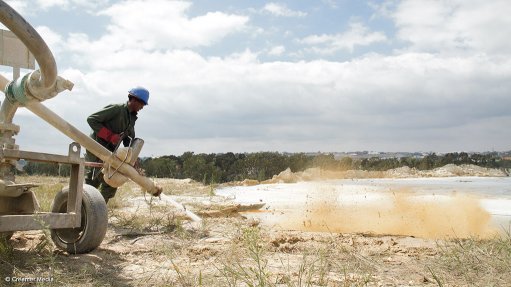
MINE WASTE Greater characterisation and classification of waste streams generated by mining activities are required under the new Nemwa regulations
Photo by: Duane Daws
The new regulations on the planning and management of residue stockpiles and deposits under the National Environmental Management Waste Act (Nemwa) will require greater characterisation and classification of waste streams generated by mining activities, such as tailings and waste rock dumps, in order to understand their risks than what was required under the Mineral and Petroleum Resources Development Act (MPRDA), says local mining consultancy The MSA Group.
More Detail The company's principal environmental consultant, Robin Bolton, tells Mining Weekly that these new regulations, which were gazetted in July, are “certainly more onerous and require more detail” than regulations under the MPRDA, requiring “greater scientific analysis” for the classification and characterisation process.
Legal services provider Cullinan & Associates associate Walter Anderson explains that, to be granted authorisation to operate stockpiles and deposits, mining operations are required to submit an environmental-impact assessment (EIA), which must comply with the more stringent requirements of the National Environmental Management Act (Nema).
Further, Anderson states that design costs are likely to increase, as Nemwa requires that stockpiles and deposits be designed by a civil or mining engineer rather than a competent person, which was the stipulation under the MPRDA.
He adds that the construction of stockpiles and deposits is also likely to incur further professional services and planning costs, as such constructiion must comply with the national norms and standards for the assessment of waste for landfill disposal and the national norms and standards for disposal of waste to landfill.
Both Anderson and Bolton assert that, while mining houses will incur additional costs to comply with the new regulations, the cost of non- compliance will be significantly higher. “To be an effective deterrent against contravention, an appropriate fine will almost certainly exceed the cost of compliance and may far exceed the R10-million fine levied under other national environmental legislation,” Anderson posits.
Meanwhile, The MSA Group environmental project manager Stephan Herb points out that one of the major changes is that a waste management licence is now required under Nemwa for mine residue stockpiles and deposits resulting from activities that require a mining right under the MPRDA. Mitigation Measures For existing mine residue deposits and stockpiles authorised under the MPRDA, management of these must continue in accordance with the approved mitigation measures prescribed in the holder’s approved environmental management plan (EMP). Existing EMPs that have been approved under the MPRDA are deemed to be approved as a waste management licence under Nemwa.
Further, Herb explains that, where there is a requirement to expand an approved stockpile or deposit and where this does not trigger the need to amend an existing licence or permit, such as a water use licence, then an amendment to the existing EMP is required. Anderson explains that the reason is that approvals granted under Regulation 73 of the MPRDA are deemed to be similiar to the new regulations concerning residue stockpiles and deposits.
These regulations are also applicable to prospecting. However, Bolton points out that an application for a waste management licence only comes into effect if residue deposits remain subsequent to prospecting activities.